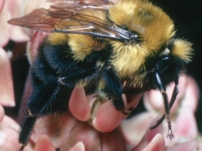

Genus: Bombus
Species: bimaculatus

Imagine you are sitting on a nice grassy field having a picnic with a couple of friends. Suddenly you spot a black and yellow flash speeding right toward you. You panic immediately but sit as still as possible. That would be the best thing to do when you see a bee. It is very likely that they wouldn't sting, but some people like to horse around with bees and try to kill them. That is when the trouble starts. The truth is, bumble bees are practically completely harmless. You just have to leave them alone and let them do their job. Let me explain more thoroughly.
Bumble bees are always the traditional bee colors of black and yellow. They are covered with long thick hairs. To us bumble bees look small but for an insect they are pretty big. Queen bumble bees are about 3/5 to 1 inch long. The other types, workers and drones, are slightly smaller than that.
Bumble bees live all over the United States and in every grassland you could find, but Bombus bimaculatus is native to the state of Iowa. In the summer they make their homes in abandoned underground nests of mice or other small creatures. The bumble eats some of the pollen that it carries from flower to flower on its hind legs like the honey bee. You may also know the stories of the bee hive and the bears always trying to get some honey. The bee mainly feeds on that honey.
When the queen first comes out of her winter resting stage, called diapause, she finds an abandoned tunnel. She makes a small mound of pollen, and lays about 5 to 10 eggs in this mound. She then seals it off with a wax cap. When the eggs hatch they are called larvae and will feed from the pollen. The queen forages and feeds the larvae herself until they turn into bees. Then they start caring for the new larvae and forage themselves. Only then does the queen stop foraging and concentrate only on laying eggs. Like the honey bee, bumble bees have workers and drones. They only store enough honey to last them through rainy days or other days that they can't fly.
Bumble bee's nests are annual. When the end of summer is near, the queen will lay some queen eggs. When these hatch, the drones fly away with the new queens and mate. The new queens will then find a protected place to spend their diapause. Only the queen survives through the winter, all the other bees die off with the first hard freeze. She wakes up in the spring and starts to make another hive.
Bumble bees play a huge role in our world. They are unique because of their sting. Unlike honey bees, the stinger of a bumble bee doesn't come off when it stings something. They fertilize or pollinate different plants or flowers in their area, helping them produce fruit. Their long tongue makes them important in pollinating certain flowers that other bees can't reach. They are also active in much cooler weather than honey bees and can pollinate plants that flower in the early spring. Without bees, many plants on our planet would not be able to reproduce and their species would become extinct. Without all those plants, animals that depended on them would starve and die. We depend on many of those animals for our food supply. We also depend on many of the plants that bumble bees pollinate.
Bumble bees have many enemies including the beetle, fly, ant, mite and wasps. They are hunted by birds and skunks. Many people do not like them because of their sting. But their population is very high. If your father or mother has a garden, next time you go outside look at the flowers and see if you can find a bee. Don't be afraid, just be silent and watch it work. I assure you that you will soon be wrapped in amazement at the bee's quick and thorough job.
Sarah B. 2000
Bibliography:
World Book Encyclopedia, 2 Scott Ferzer Company, 1983-1996 World Book Inc.
"Animals", Groliers Multimedia Encyclopedia, (5/6/00).
"Bumble Bee", http://www.pollination.com/IPSbumbee.html, (7/30/00).
"Bumble Bee", http://www.holoweb.com/cannon/bumblebe.htm (7/30/00).